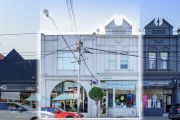
The shopping strips that are among the nation's hardest to buy into
Owning a shop on some suburban streets can be a tough nut to crack.
Many of the nation’s tightest-held shopping strips are small, most are in locations that have solid passing traffic and are so popular that buildings often get passed down through generations.
If you happen to scoop up a shop in one of these strips, one thing is for sure: you’re set to be part of an exclusive club.
Perth: Napoleon Street, Cottlesloe
 36 Napoleon Street has been held by the same owner since 2003. Photo: Supplied
36 Napoleon Street has been held by the same owner since 2003. Photo: Supplied
One of the most prestigious beachside suburbs in Australia is also home to one of the most tightly held shopping strips in the country.
Brett Wilkins, a senior director at Lease Equity, is marketing a retail shop in Napoleon Street – where there has only been one independent sale in the past decade.
“The precinct is one of the most tightly held suburban retail strips in Perth. Sales along the strip are extremely rare,” he said.
”The owner has held the property since 2003 and there has only been one single independent sale in 10 years. There is also the opportunity in the future to develop the property towards the rear boundary or build a second level.”
Melbourne: Maling Road, Canterbury
 The former Maling Post Office building, which sold last year for the time in 100 years. Photo: Supplied
The former Maling Post Office building, which sold last year for the time in 100 years. Photo: Supplied
Maling Road shopping village in Canterbury, Melbourne, is one of the city’s most exclusive. When the former post office, on the corner of Maling and Canterbury roads, came on the market last year it was the first time it had been sold in 100 years. And the market responded strongly, too, according to listing agent Ben Baines, with a “local private investor” picking the property up for $7,365,000 (representing a 4.23 per cent yield) at auction.
Colliers International puts the number of sales in the road at fewer than 10, and Mr Baines said it was “certainly one of the more tightly held strips around”.
“This sale represents only the ninth retail purchasing opportunity on Maling Road in the last decade,” agent Tom Noonan said.
Honourable mention: Church Street, Brighton
Mr Baines believes that Maling Road, as well as Church Street in Brighton, are among of the most tightly held shopping strips in the city.
Sydney: Bronte Road, Bronte
 The shop opposite Bronte beach is expected to sell for about $2 million. Photo: Supplied
The shop opposite Bronte beach is expected to sell for about $2 million. Photo: Supplied
The small stretch of shops adjacent to Bronte Beach is home to just nine businesses, and only one of them has sold in the past decade. That might be about to change, with the fish and chip shop recently listed with a guide of about $2 million. It hasn’t been traded since 1988.
Honourable mention: Dixon Street, Haymarket
Chinatown was in the headlines recently, with a building in Dixon Street which had been held by the same family for over a century selling under the hammer for $19.9 million.
According to listing agent Dominic Ong of Knight Frank it was the first freestanding building sold in Dixon Street in more than 30 years.
Canberra: Franklin Street, Manuka; and Kennedy Street, Kingston
The Kingston Foreshore might be all the rage, but when it comes to owning shops these two streets further back from the Lake are both widely regarded as being among the most tightly held in the national capital.
There has been seven sales in the Kennedy shopping precinct in the past decade, and just six in the Manuka Village precinct.
Adelaide: Mount Barker Road, Hahndorf
 Mount Barker Road in Hahndorf, South Australia is one of the state’s most tightly held shopping strips. Photo: Supplied
Mount Barker Road in Hahndorf, South Australia is one of the state’s most tightly held shopping strips. Photo: Supplied
Okay, so it’s on the very outskirts of Adelaide (Adelaide Hills to be specific), but Hahndorf, the oldest German settlement in Australia, is possibly home to one of the most tightly held shopping strips in the state, with only four sales in Mount Barker Road in the last decade.
Romualdo Cicchiello, of LJ Hooker Commercial, currently has a listing incorporating a residence, motel, restaurant and three retail shops for sale in the town.
Mr Cicchiello said that many shop owners tended to live locally, with a number of those being owner occupiers, meaning stock rarely changed hands.
“Vacancy rates are quite low along that strip so tenants tend to stay and pay rent. There are a lot of owners who operate their business and live in the area,” he said.










